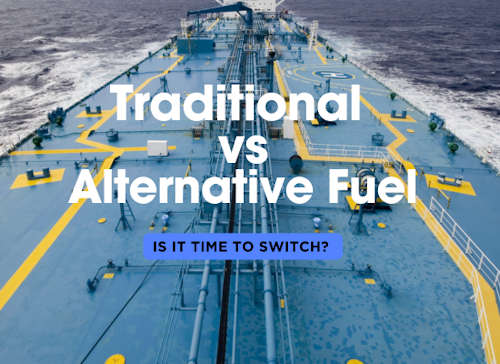Time to Consider a Switch? Traditional vs. Alternative Fuels

In maritime shipping choosing the right fuel may not be as simple as sticking to diesel. With evolving environmental regulations, fluctuating oil prices, and growing sustainability efforts, ship and fleet owners are exploring alternative fuel options like LNG, biofuels, methanol, and even hydrogen. This guide provides a detailed comparison of diesel versus its alternatives, weighing the pros and cons based on real-world data. From fuel costs to emissions and infrastructure availability, we’ll break down the key factors that ship owners need to consider when making the switch or sticking with traditional fuels.
Note: We are not covering alternative fuels such as wind/solar in this article.
Fuel Types
When it comes to fueling your fleet, the choice between diesel and alternative fuels like LNG, biofuels, methanol, or hydrogen isn’t just about price. Each fuel has different energy outputs, emissions profiles, and availability across global shipping routes. While diesel has long been the industry standard, the alternatives offer environmental benefits and may soon be more accessible as regulations tighten. Below is a detailed breakdown of the key fuel types in maritime shipping, giving you a clearer picture of the pros, cons, and what might work best for your vessels.
| ShipUniverse: Fuel Types Overview | ||||
| Fuel Type | Energy Density (MJ/kg) | CO2 Emissions (g/kWh) | Global Availability | Cost per Ton (USD) |
| Diesel | 45 | 600 | Widespread globally | 850-1,200 |
| LNG (Liquefied Natural Gas) | 50 | 450 | Expanding in major ports | 500-900 |
| Biofuels | 37 | 250-500 (varies) | Limited but growing | 900-1,500 |
| Methanol | 20 | 350 | Available in select ports | 500-750 |
| Hydrogen | 120 (as gas) | Zero | Very limited infrastructure | 1,500-2,000 |
Key Points
Diesel: The Traditional Powerhouse, But At What Cost?
- Energy Density: 45 MJ/kg – Diesel packs a solid punch.
- CO2 Emissions: 600 g/kWh – A major contributor to greenhouse gases.
- Global Availability: Available almost everywhere, making it convenient for global shipping routes.
- Cost: $850-$1,200 per ton – Prone to fluctuations in global oil markets.
While diesel is reliable and available globally, its high emissions and price volatility are making shipowners reconsider long-term reliance on it.
LNG: The Rising Star in Maritime Shipping
- Energy Density: 50 MJ/kg – Slightly better than diesel, offering more energy per kilogram.
- CO2 Emissions: 450 g/kWh – A cleaner option for emissions.
- Global Availability: Growing, especially in major ports with new LNG bunkering infrastructure.
- Cost: $500-$900 per ton – More affordable than diesel with less volatility.
LNG is a promising alternative for shipowners looking to lower fuel costs and reduce emissions. However, the cost of converting fleets to run on LNG is still a consideration.
Biofuels: Green and Versatile, But Pricey
- Energy Density: 37 MJ/kg – Slightly lower than diesel but acceptable for maritime use.
- CO2 Emissions: 250-500 g/kWh – Varies based on the feedstock, but generally a cleaner choice.
- Global Availability: Limited, but growing as biofuel production expands.
- Cost: $900-$1,500 per ton – Pricing can fluctuate heavily due to production factors.
Biofuels offer a greener alternative with fewer retrofitting costs since they can often be mixed with diesel, but their price and supply can be unpredictable.
Methanol: Affordable and Clean, But Less Efficient
- Energy Density: 20 MJ/kg – Lower energy output compared to diesel and LNG.
- CO2 Emissions: 350 g/kWh – A cleaner combustion profile than diesel.
- Global Availability: Available in select ports, but not yet widespread.
- Cost: $500-$750 per ton – Affordable and relatively stable in pricing.
Methanol presents an interesting, cleaner-burning option, though it suffers from lower energy output. For now, its availability limits its appeal.
Hydrogen: The Future of Clean Energy – But Are We There Yet?
- Energy Density: 120 MJ/kg (as gas) – The most powerful in terms of energy content.
- CO2 Emissions: Zero – No CO2 emissions, making it the cleanest fuel option.
- Global Availability: Very limited, with infrastructure still in early stages.
- Cost: $1,500-$2,000 per ton – Expensive due to production and storage complexities.
Hydrogen is the ultimate green fuel, offering zero emissions and massive energy potential. But the infrastructure needed to store and transport it, combined with its high cost, keeps it out of reach for many fleet owners… at least for now.
Key Takeaways
- Diesel: Reliable and widely available but heavy on emissions and costs.
- LNG: A cleaner, more affordable alternative growing in availability.
- Biofuels: Green but inconsistent in supply and price.
- Methanol: Cleaner and affordable but with lower energy efficiency.
- Hydrogen: The ultimate green fuel, though currently limited by cost and infrastructure.
As the maritime industry navigates stricter environmental regulations, alternative fuels like LNG and biofuels are becoming more attractive, while hydrogen sits on the horizon as the clean energy solution of the future. Shipowners must weigh the costs and benefits of transitioning to these new fuels based on their fleet’s operational needs.
Efficiency and Performance
As shipowners explore the shift from traditional diesel to alternative fuels, it's important to consider not only the upfront costs but also the long-term implications. Fuel efficiency plays a critical role in determining operational expenses over a ship's lifespan, especially for long-haul routes. In addition, maintenance, safety, and compliance with regulatory frameworks like IMO 2020 have become more stringent, which can directly impact your bottom line. Below, we dive into how different fuels perform in terms of efficiency, operational costs, and future availability, providing shipowners with a comprehensive view to help them make informed decisions.
| ShipUniverse: Fuel Efficiency and Performance | ||||
| Fuel Type | Energy Efficiency (MJ/kg) | Range on Full Tank (nautical miles) | Engine Compatibility | Performance in Short-Haul vs Long-Haul |
| Diesel | 45 | 10,000 (long-haul) | Widely compatible with most ship engines | Performs well in both short and long-haul |
| LNG | 50 | 12,000 (long-haul) | Requires engine modifications or new builds | Better suited for long-haul due to efficiency |
| Biofuels | 37 | 9,000 (long-haul) | Compatible with existing diesel engines (blends) | Best for short-haul, but can handle long-haul |
| Methanol | 20 | 7,000 (long-haul) | Requires specialized engines | Limited range, better for short-haul |
| Hydrogen | 120 (as gas) | 15,000 (long-haul) | Requires new engine designs and infrastructure | Extremely efficient for long-haul, still experimental for short-haul |
Key Points
Fuel Efficiency and Performance: The Long Haul vs. Short Haul Debate
When it comes to fuel efficiency and performance, not all fuels are created equal. The type of fuel you choose can significantly impact your ship’s range and efficiency, especially for long-haul routes.
- Diesel: A solid performer across both short and long-haul routes. Its compatibility with most ship engines and an average range of 10,000 nautical miles per tank make it reliable, though not the most efficient.
- LNG: With a range of 12,000 nautical miles, LNG offers better efficiency than diesel, making it ideal for long-haul routes. The downside? Engine modifications are required, adding to the initial cost.
- Biofuels: Perfect for fleets that want to dip their toes into cleaner energy without committing to engine modifications. Biofuels offer a decent range but shine in short-haul applications.
- Methanol: Methanol is affordable and clean, but with a lower energy density and range of 7,000 nautical miles, it’s best suited for short-haul trips.
- Hydrogen: The energy king with a range of 15,000 nautical miles on a full tank! However, hydrogen is still mostly experimental, with significant infrastructure and engine redesigns needed.
Maintenance and Operational Costs: The Hidden Price of Going Green
Switching fuels isn’t just about fuel prices. You also need to factor in maintenance, downtime, and storage requirements. Some fuels demand more frequent maintenance, while others require specialized storage that can drive up operational costs.
- Diesel: Simple, easy-to-store, and with relatively low maintenance costs ($100,000/year), diesel remains cost-effective. But its emissions-related wear on engines adds to long-term costs.
- LNG: More expensive to maintain at $200,000/year, largely due to the complexity of storing LNG in cryogenic tanks. Expect around 8 days of downtime annually due to fuel-specific issues.
- Biofuels: Maintenance is manageable, with storage requirements similar to diesel, keeping costs lower ($120,000/year). However, fuel consistency can vary, leading to operational hiccups.
- Methanol: Requires corrosion-resistant tanks, which bumps up maintenance to $150,000/year. While safer than LNG, it’s not as straightforward as diesel.
- Hydrogen: With $300,000/year in maintenance and 10 days of downtime, hydrogen remains the most expensive fuel to maintain due to its high-pressure or cryogenic storage needs.
Fuel Availability Projections: The Future is Green, But How Soon?
As we head towards 2030 and beyond, the global availability of fuel types will shift, driven by environmental policies, extraction methods, and refining capacities. Here's what the future looks like for each fuel:
- Diesel: On the decline. By 2030, demand will drop by 20%, and by 2050, it’s expected to plummet by 50% as fleet owners adopt greener alternatives.
- LNG: Growing in popularity. Expect a 30% increase in demand by 2030, with steady growth into 2050 as it becomes a more accessible alternative.
- Biofuels: The future is bright! Demand will soar by 50% by 2030 and could double by 2050, thanks to its adaptability and lower emissions.
- Methanol: A rising star in the fuel world, with a 40% demand increase by 2030 and even more by 2050. Its cost-effectiveness and cleaner emissions make it appealing.
- Hydrogen: Still experimental but projected to grow significantly by 2050 and beyond as infrastructure catches up and production becomes more cost-effective.
Regulatory Compliance Costs: Staying on the Right Side of the Law
With the IMO’s increasingly stringent regulations on emissions, compliance is no longer optional. Here’s how different fuels compare when it comes to the cost of staying compliant.
- Diesel: The bad news? Diesel users face heavy fines and expensive compliance upgrades (like scrubbers) to meet IMO 2020 standards.
- LNG: Much easier to stay compliant, with built-in advantages due to its lower emissions profile. LNG users can expect cost savings by avoiding hefty fines.
- Biofuels: Biofuels come with fewer compliance concerns, but consistency in fuel quality can sometimes complicate matters.
- Methanol: Cleaner than diesel and LNG, methanol complies with current emissions standards and is expected to meet future regulations without major upgrades.
- Hydrogen: The clear winner when it comes to emissions compliance, hydrogen is zero-emission, allowing shipowners to bypass future fines and penalties altogether.
As the maritime industry navigates the waters of cleaner fuel options, it's clear that alternative fuels like LNG and biofuels are taking center stage for long-term sustainability. Diesel might still be the most familiar choice, but its costs and emissions challenges make it less attractive. Hydrogen holds the most promise for the future, but the infrastructure needs to catch up before it becomes a viable widespread option. Balancing costs, compliance, and long-term availability will be key for shipowners looking to future-proof their operations.
TCO: Total Cost of Ownership
When it comes to determining the true cost of a fuel choice, the Total Cost of Ownership (TCO) offers a comprehensive view by considering not just the upfront costs, but also long-term expenses such as maintenance, operational costs, regulatory compliance, and even downtime. It’s important to note that TCO can fluctuate wildly based on market conditions, geographic location, and vessel-specific factors like the age of the ship and routes it typically sails. Below is a table that attempts to break down the TCO for different fuel types over a 10-year span, giving shipowners a clearer picture of the long-term financial commitment involved with each option.
| ShipUniverse: Total Cost of Ownership (TCO) Over 10 Years | ||||
| Fuel Type | Fuel Costs (USD) | Maintenance Costs (USD) | Regulatory Compliance Costs (USD) | Downtime Costs (USD) |
| Diesel | $8-10 million | $1 million | $500,000 for scrubbers, fines | $300,000 (due to fuel-related issues) |
| LNG | $7-9 million | $2 million (due to specialized storage) | $100,000 (lower compliance costs) | $500,000 (due to fuel-specific downtime) |
| Biofuels | $9-12 million | $1.2 million | $200,000 | $200,000 (minimal downtime) |
| Methanol | $6-8 million | $1.5 million | $150,000 | $250,000 (due to storage requirements) |
| Hydrogen | $15-18 million | $3 million | $0 (zero-emission fuel) | $700,000 (high storage and handling downtime) |

Do you have a Maritime Product or Service that may be of interest to Shipowners? Tell us about it here!
Do you have feedback or insights? Please reach out to editor @ shipuniverse.com



